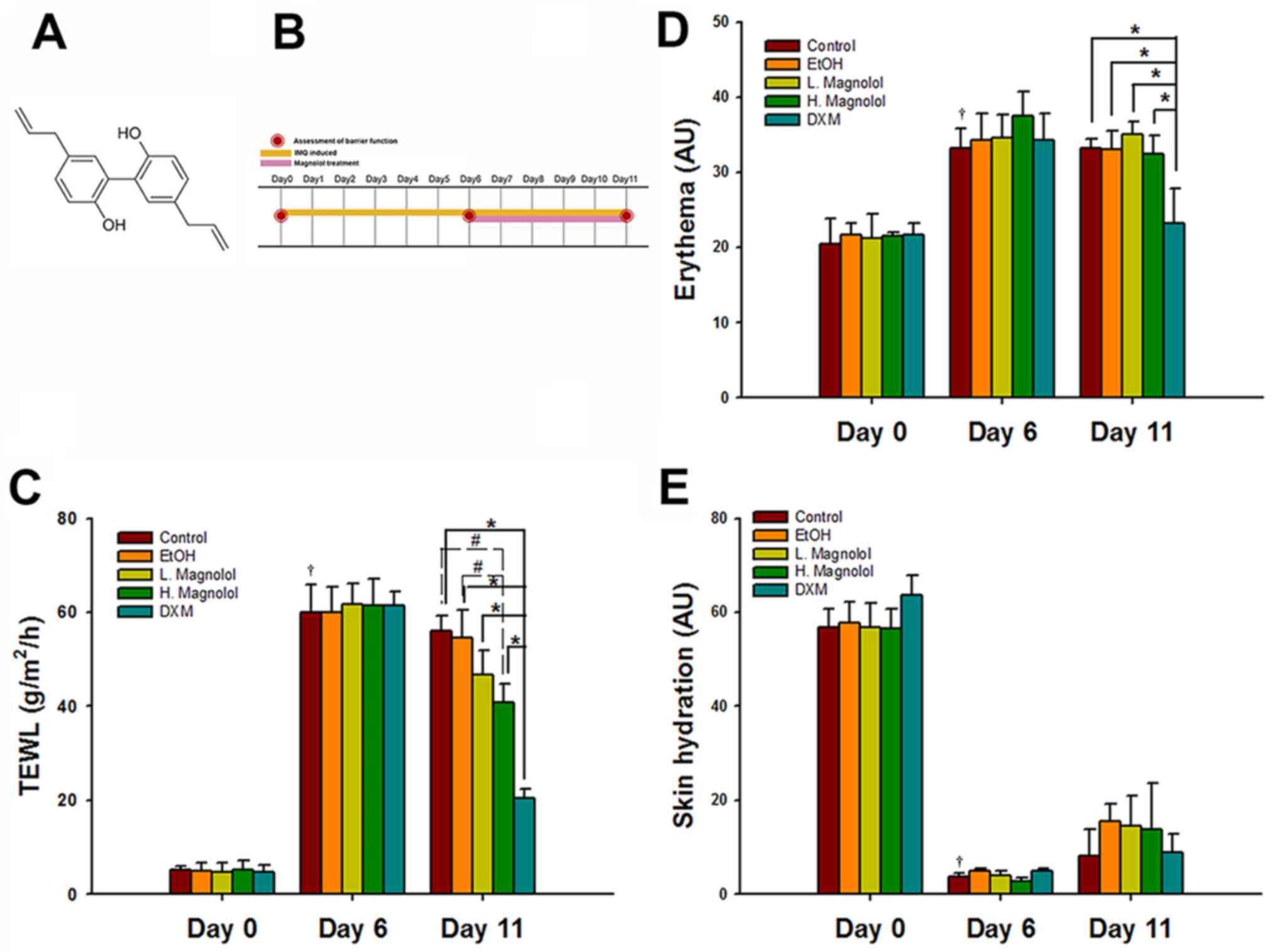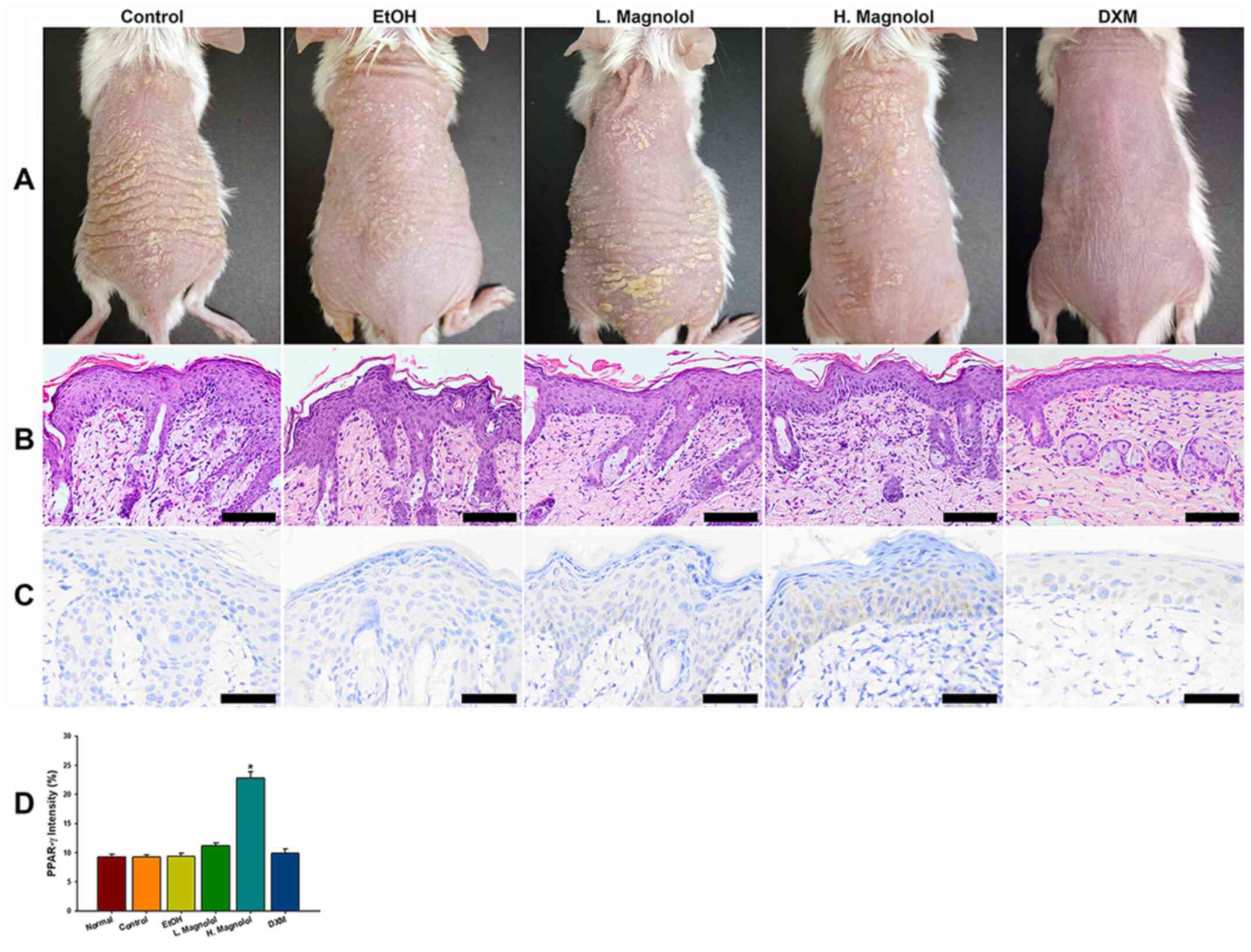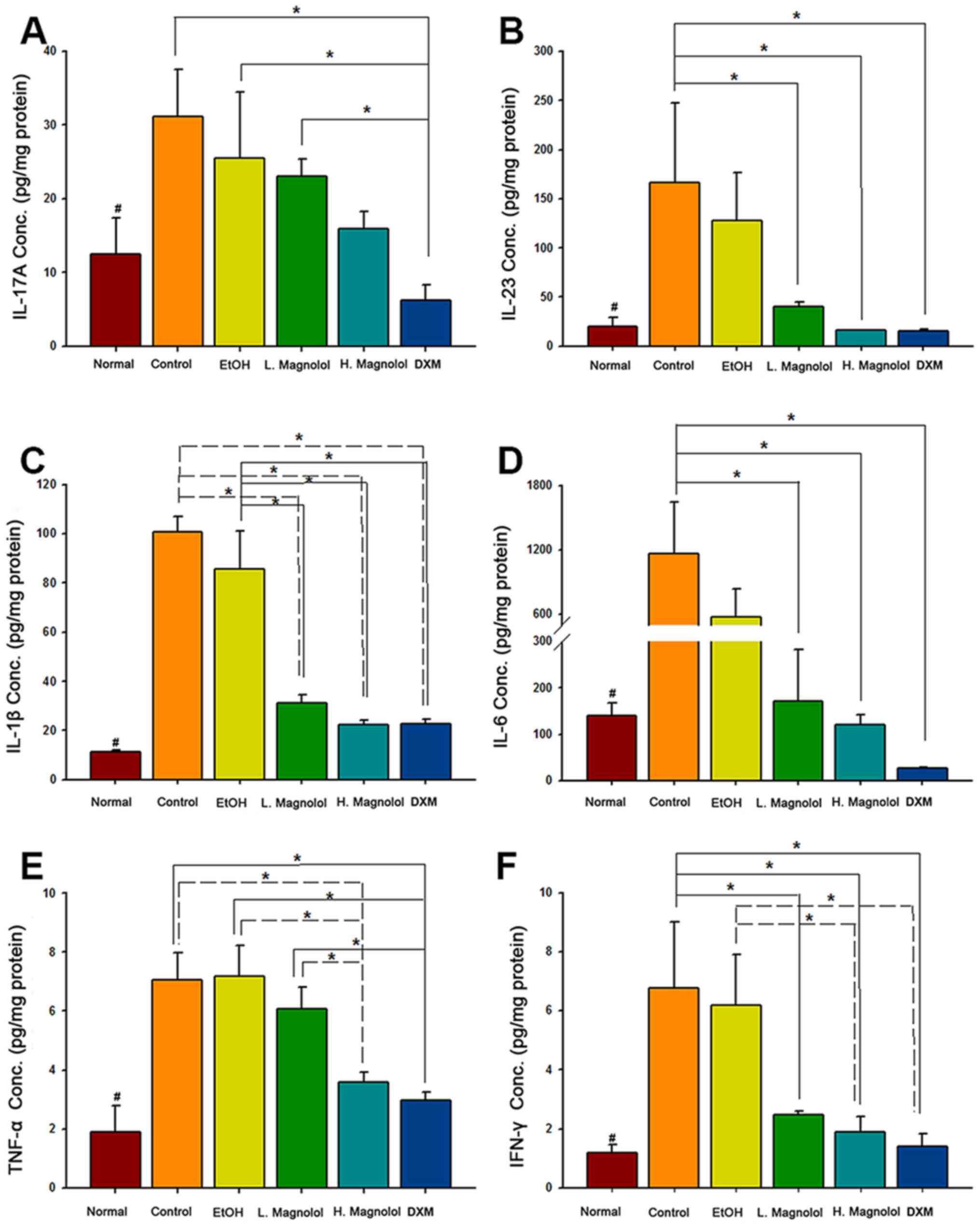|
1
|
Elias PM, Hatano Y and Williams ML: Basis
for the barrier abnormality in atopic dermatitis:
Outside-inside-outside pathogenic mechanisms. J Allergy Clin
Immunol. 121:1337–1343. 2008.PubMed/NCBI View Article : Google Scholar
|
|
2
|
Azfar RS and Gelfand JM: Psoriasis and
metabolic disease: Epidemiology and pathophysiology. Curr Opin
Rheumatol. 20:416–422. 2008.PubMed/NCBI View Article : Google Scholar
|
|
3
|
Gudjonsson JE and Elder JT: Psoriasis. In:
Fitzpatrick's Dermatology in General Medicine. Goldsmith LA, Kazt
SI, Gilchrest BA, Paller AD, Leffell DJ and Wolff K (eds.).
McGraw-Hill Companies, Inc., 2012.
|
|
4
|
Boehncke WH and Schon MP: Psoriasis.
Lancet. 386:983–994. 2015.PubMed/NCBI View Article : Google Scholar
|
|
5
|
Di Cesare A, Di Meglio P and Nestle FO:
The IL-23/Th17 axis in the immunopathogenesis of psoriasis. J
Invest Dermatol. 129:1339–1350. 2009.PubMed/NCBI View Article : Google Scholar
|
|
6
|
Toussirot E: The IL23/Th17 pathway as a
therapeutic target in chronic inflammatory diseases. Inflamm
Allergy Drug Targets. 11:159–168. 2012.PubMed/NCBI View Article : Google Scholar
|
|
7
|
Bowcock AM: The genetics of psoriasis and
autoimmunity. Annu Rev Genomics Hum Genet. 6:93–122.
2005.PubMed/NCBI View Article : Google Scholar
|
|
8
|
Alonso-Castro AJ, Zapata-Bustos R,
Dominguez F, Garcia-Carranca A and Salazar-Olivo LA: Magnolia
dealbata Zucc and its active principles honokiol and magnolol
stimulate glucose uptake in murine and human adipocytes using the
insulin-signaling pathway. Phytomedicine. 18:926–933.
2011.PubMed/NCBI View Article : Google Scholar
|
|
9
|
Dominguez F, Chavez M, Garduno-Ramirez ML,
Chavez-Avila VM, Mata M and Cruz-Sosa F: Honokiol and magnolol
production by in vitro micropropagated plants of Magnolia dealbata,
an endangered endemic Mexican species. Nat Prod Commun. 5:235–240.
2010.PubMed/NCBI
|
|
10
|
Kuo DH, Lai YS, Lo CY, Cheng AC, Wu H and
Pan MH: Inhibitory effect of magnolol on TPA-induced skin
inflammation and tumor promotion in mice. J Agric Food Chem.
58:5777–5783. 2010.PubMed/NCBI View Article : Google Scholar
|
|
11
|
Lee YJ, Lee YM, Lee CK, Jung JK, Han SB
and Hong JT: Therapeutic applications of compounds in the Magnolia
family. Pharmacol Ther. 130:157–176. 2011.PubMed/NCBI View Article : Google Scholar
|
|
12
|
Lin CF, Hwang TL, Al-Suwayeh SA, Huang YL,
Hung YY and Fang JY: Maximizing dermal targeting and minimizing
transdermal penetration by magnolol/honokiol methoxylation. Int J
Pharm. 445:153–162. 2013.PubMed/NCBI View Article : Google Scholar
|
|
13
|
Shen JL, Man KM, Huang PH, Chen WC, Chen
DC, Cheng YW, Liu PL, Chou MC and Chen YH: Honokiol and magnolol as
multifunctional antioxidative molecules for dermatologic disorders.
Molecules. 15:6452–6465. 2010.PubMed/NCBI View Article : Google Scholar
|
|
14
|
Tanaka K, Hasegawa J, Asamitsu K and
Okamoto T: Magnolia ovovata extract and its active component
magnolol prevent skin photoaging via inhibition of nuclear factor
kappaB. Eur J Pharmacol. 565:212–219. 2007.PubMed/NCBI View Article : Google Scholar
|
|
15
|
Dreier D, Latkolik S, Rycek L, Schnürch M,
Dymáková A, Atanasov AG, Ladurner A, Heiss EH, Stuppner H, Schuster
D, et al: Linked magnolol dimer as a selective PPARg
agonist-Structure-based rational design, synthesis, and bioactivity
evaluation. Sci Rep. 7(13002)2017.PubMed/NCBI View Article : Google Scholar
|
|
16
|
Wang L, Waltenberger B, Pferschy-Wenzig
EM, Blunder M, Liu X, Malainer C, Blazevic T, Schwaiger S,
Rollinger JM, Heiss EH, et al: Natural product agonists of
peroxisome proliferator-activated receptor gamma (PPARg): A review.
Biochem Pharmacol. 92:73–89. 2014.PubMed/NCBI View Article : Google Scholar
|
|
17
|
Dreier D, Resetar M, Temml V, Rycek L,
Kratena N, Schnürch M, Schuster D, Dirsch VM and Mihovilovic MD:
Magnolol dimer-derived fragments as PPARg-selective probes. Org
Biomol Chem. 16:7019–7028. 2018.PubMed/NCBI View Article : Google Scholar
|
|
18
|
Mao-Qiang M, Fowler AJ, Schmuth M, Lau P,
Chang S, Brown BE, Moser AH, Michalik L, Desvergne B, Wahli W, et
al: Peroxisome-proliferator-activated receptor (PPAR)-gamma
activation stimulates keratinocyte differentiation. J Invest
Dermatol. 123:305–312. 2004.PubMed/NCBI View Article : Google Scholar
|
|
19
|
Flori E, Mastrofrancesco A, Kovacs D,
Bellei B, Briganti S, Maresca V, Cardinali G and Picardo M: The
activation of PPARg by 2,4,6-Octatrienoic acid protects human
keratinocytes from UVR-induced damages. Sci Rep.
7(9241)2017.PubMed/NCBI View Article : Google Scholar
|
|
20
|
Horvath S, Komlodi R, Perkecz A, Pinter E,
Gyulai R and Kemeny A: Methodological refinement of Aldara-induced
psoriasiform dermatitis model in mice. Sci Rep.
9(3685)2019.PubMed/NCBI View Article : Google Scholar
|
|
21
|
Chong HT, Yang GN, Sidhu S, Ibbetson J,
Kopecki Z and Cowin AJ: Reducing Flightless I expression decreases
severity of psoriasis in an imiquimod-induced murine model of
psoriasiform dermatitis. Br J Dermatol. 176:705–712.
2017.PubMed/NCBI View Article : Google Scholar
|
|
22
|
van der Fits L, Mourits S, Voerman JS,
Kant M, Boon L, Laman JD, Cornelissen F, Mus AM, Florencia E, Prens
EP and Lubberts E: Imiquimod-induced psoriasis-like skin
inflammation in mice is mediated via the IL-23/IL-17 axis. J
Immunol. 182:5836–5845. 2009.PubMed/NCBI View Article : Google Scholar
|
|
23
|
Guo JW, Cheng YP, Liu CY, Thong HY, Huang
CJ, Lo Y, Wu CY and Jee SH: Salvianolic acid B in microemulsion
formulation provided sufficient hydration for dry skin and
ameliorated the severity of imiquimod-induced psoriasis-like
dermatitis in mice. Pharmaceutics. 12(457)2020.PubMed/NCBI View Article : Google Scholar
|
|
24
|
Lin ZM, Ma M, Li H, Qi Q, Liu YT, Yan YX,
Shen YF, Yang XQ, Zhu FH, He SJ, et al: Topical administration of
reversible SAHH inhibitor ameliorates imiquimod-induced
psoriasis-like skin lesions in mice via suppression of
TNF-α/IFN-g-induced inflammatory response in keratinocytes and T
cell-derived IL-17. Pharmacol Res. 129:443–452. 2018.PubMed/NCBI View Article : Google Scholar
|
|
25
|
Li YL, Du ZY, Li PH, Yan L, Zhou W, Tang
YD, Liu GR, Fang YX, Zhang K, Dong CZ and Chen HX:
Aromatic-turmerone ameliorates imiquimod-induced psoriasis-like
inflammation of BALB/c mice. Int Immunopharmacol. 64:319–325.
2018.PubMed/NCBI View Article : Google Scholar
|
|
26
|
OuYang Q, Pan Y, Luo H, Xuan C and Liu J
and Liu J: MAD ointment ameliorates imiquimod-induced psoriasiform
dermatitis by inhibiting the IL-23/IL-17 axis in mice. Int
Immunopharmacol. 39:369–376. 2016.PubMed/NCBI View Article : Google Scholar
|
|
27
|
Ramot Y, Mastrofrancesco A, Camera E,
Desreumaux P, Paus R and Picardo M: The role of PPARγ-mediated
signalling in skin biology and pathology: New targets and
opportunities for clinical dermatology. Exp Dermatol. 24:245–251.
2015.PubMed/NCBI View Article : Google Scholar
|
|
28
|
Burgermeister E and Seger R: MAPK kinases
as nucleo-cytoplasmic shuttles for PPARgamma. Cell Cycle.
6:1539–1548. 2007.PubMed/NCBI View Article : Google Scholar
|
|
29
|
Burgermeister E, Chuderland D, Hanoch T,
Meyer M, Liscovitch M and Seger R: Interaction with MEK causes
nuclear export and downregulation of peroxisome
proliferator-activated receptor gamma. Mol Cell Biol. 27:803–817.
2007.PubMed/NCBI View Article : Google Scholar
|
|
30
|
Westergaard M, Henningsen J, Svendsen ML,
Johansen C, Jensen UB, Schrøder HD, Kratchmarova I, Berge RK,
Iversen L, Bolund L, et al: Modulation of keratinocyte gene
expression and differentiation by PPAR-selective ligands and
tetradecylthioacetic acid. J Invest Dermatol. 116:702–712.
2001.PubMed/NCBI View Article : Google Scholar
|
|
31
|
Mastrofrancesco A, Kovacs D, Sarra M,
Bastonini E, Cardinali G, Aspite N, Camera E, Chavatte P,
Desreumaux P, Monteleone G and Picardo M: Preclinical studies of a
specific PPARg modulator in the control of skin inflammation. J
Invest Dermatol. 134:1001–1011. 2014.PubMed/NCBI View Article : Google Scholar
|
|
32
|
Demerjian M, Man MQ, Choi EH, Brown BE,
Crumrine D, Chang S, Mauro T, Elias PM and Feingold KR: Topical
treatment with thiazolidinediones, activators of peroxisome
proliferator-activated receptor-gamma, normalizes epidermal
homeostasis in a murine hyperproliferative disease model. Exp
Dermatol. 15:154–160. 2006.PubMed/NCBI View Article : Google Scholar
|
|
33
|
Poivre M and Duez P: Biological activity
and toxicity of the Chinese herb magnolia officinalis rehder &
E. Wilson (Houpo) and its constituents. J Zhejiang Univ Sci B.
18:194–214. 2017.PubMed/NCBI View Article : Google Scholar
|
|
34
|
Wen J, Wang X, Pei H, Xie C, Qiu N, Li S,
Wang W, Cheng X and Chen L: Anti-psoriatic effects of Honokiol
through the inhibition of NF-kappaB and VEGFR-2 in animal model of
K14-VEGF transgenic mouse. J Pharmacol Sci. 128:116–124.
2015.PubMed/NCBI View Article : Google Scholar
|
|
35
|
Tsai ZX, Mo SY and Zhu SG: Effect and
mechanism of Magnolol on psoriasis mice induced by imiquimod. Chin
J Clin Pharmacol. 35:56–59. 2019.(In Chinese).
|

















